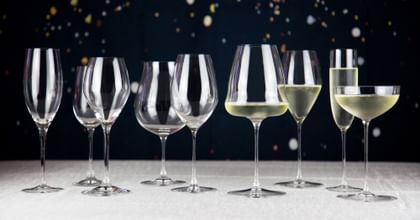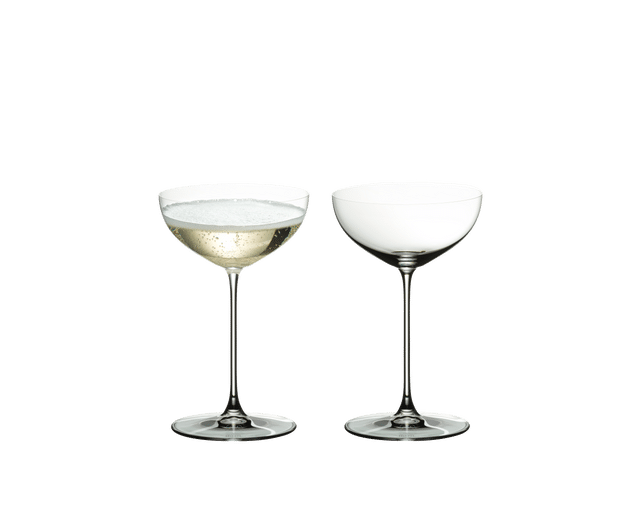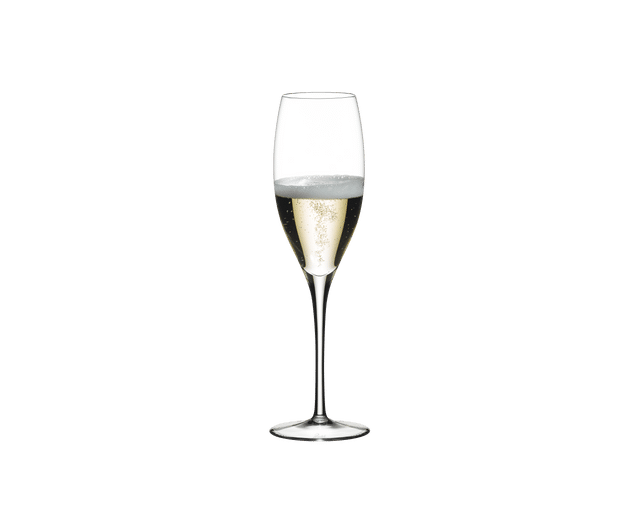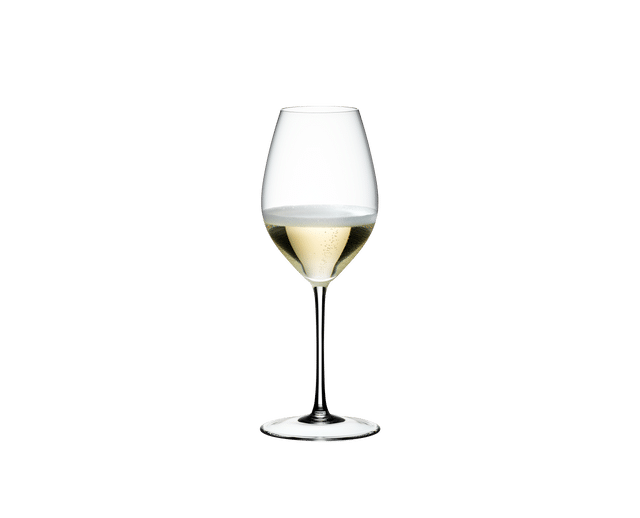Knowledge
The Evolution of the Champagne Glass

It wasn’t long ago that, after opening a bottle of champagne, most of us would automatically reach for our trusty flutes. However, over the past couple of years, the question has been raised about how to serve champagne to show it at its best. We’ve known for over forty years that a glass’ shape has an impact on your perception of aroma and flavour, so why do we continue to think differently for champagne?
The majority of champagne is made up of three grape varieties - Pinot Noir, Chardonnay, and Pinot Meunier - and some of the production methods are the same between still and sparkling wines. The real significant difference comes down to the bubbles.
The average bottle of quality champagne is about €35 / US$60 / AUD$60. Now, imagine that you’ve bought a bottle of red wine for the equivalent cost. Would you crack it open and pour it into the closest mug or cup? Or would you perhaps decant it, monitor the temperature, consider the best glass to use, and savour it over a meal?
We’re happy to exchange our Pinot Noir glasses for Shiraz glasses when changing from one varietal to the next, so why are we letting champagne’s bubbles dominate our habits? It’s mostly to do with tradition, and how the history of champagne has shaped our views of what vessel it belongs in.

The Coupe
Rumour has it that Marie Antoinette's left breast inspired the shape of this glass. The glass' origin predates the French Queen so, while a good story, it's not true.
However, the Coupe was popular during her time on the throne, as champagne produced at the time was sweeter and more syrupy. The saucer's short sides and shallow bowl made it easy for you to dip your cake in it. Indulgent, yes, but let's be honest: if you could soak your dessert in champagne, wouldn't you?
The glass had a resurgence in the 1920s, again in the 1960s, then became popular a few years ago, to the disappointment of devout champagne lovers. While it may help you live the life of a flapper, its shape is completely ineffective when it comes to expressing the wine's profile.
The open design causes both the bubbles and aroma to dissipate almost immediately and, if you consider that 70% of our perception of flavour comes from the aroma, you're losing a lot of your experience for fashion's sake.
So where to after the champagne saucer?
About fifty years ago, champagne was significantly cheaper than it is today so was accessible to more drinkers. While this might seem positive for business, the champagne houses could only produce quality at a specific rate, and demand was outstripping supply.
So they did what any group of smart business people would do: they changed the dialogue around champagne. Just as the diamond industry convinced us diamonds are the only option when proposing, the champagne industry convinced us that it is something special, saved for celebrations. Suddenly they could increase the price, making it less accessible.

The Flute
Now thought of as something used primarily for special occasions, champagne drinkers needed a glass that allowed the bottle to be shared among many. The flute's slim design made it perfect for toasting and provided a measured pour. As a result, the glass itself has now become a symbol of celebration. If you turn up to a friend's place and see flutes on the bench, you automatically know you're in for a good time!
Flutes also have the benefit of enhancing the bead. All quality products include a small scratch or mark at the base that agitates the champagne, encouraging it to stay bubbly as you drink.
The downside is that it doesn't provide a perfect expression of aroma due to its thin opening. Even tulip-shaped flutes with more rounded bowls won't provide you with the full aromatic experience.
In 2013, Riedel began hosting sensory workshops to find the best glass shape for balance and expression. We discovered what we have long suspected: that the best glass for drinking champagne is a wine glass.
Drinking champagne from a wine glass is about simply that - drinking. It evolves champagne from something that is only for a toast, into something worthy of savouring and enjoying. From our workshops, we determined two winning shapes depending on the style of champagne.

The Glass
A tall white wine glass with a tulip shape is better suited for leaner champagnes like Blanc de Blanc, made primarily from Chardonnay grapes. Its modest bowl size develops the aromas without overwhelming them, particularly in vintage champagnes where time has allowed the characteristics to become more complex.
To elevate the more opulent rosé champagnes, derived mainly from Pinot Noir and Pinot Meunier grapes, the New World Pinot Noir bowl is unbeatable. It outperformed flutes by a mile to show impressive depth of character.
Our Veritas series is the first in the world to feature a glass (not a flute) designed specifically for drinking champagne, as you would still wine. The Veritas Champagne Glass features a curved egg-shaped bowl with a small opening to envelop the aroma.
We have since hosted flute vs. glass comparisons with everyday wine drinkers, and every participant is always amazed at the difference it makes. As a result, all of Riedel's newer lines are developed with this bowl shape for Champagne instead of a flute.
As 11th generation Maximilian J. Riedel’s puts it: "Champagne is a wine and deserves to be treated as such. Whether enjoying a Blanc de Blancs or a Cuvée, our Champagne wine glass allows the range of aromas of Champagne to unfold in a way which is not possible with a narrow flute."
So what does this all mean?
Both sides of the debate continue to be hotly debated. Dom Pérignon is said to have been the first to adopt the flute as champagne’s nominated vessel, saying he enjoyed being able to "watch the dance of the sparkling atoms." On the other hand, Olivier Krug, current Krug director and great-great-great-grandson of the founder, is adamant that, "A great Champagne cannot offer its fullest expression in a narrow glass."
The best champagne glass for you is based on how and when you enjoy champagne, and what styles you like to drink. While we wouldn’t recommend drinking vintage champagne out of a plastic cup, you might be a content traditionalist who can’t go past the classic flute, or perhaps you love to be ahead of the curve and drink champagne from your stemless O Tumblers.
But if you’d walk over hot coals for a glass of the good stuff, do a quick glass comparison the next time you open something special. Our only warning: don’t try this in large numbers as once you drink champagne from a wine glass, you may not want to share!
Locations